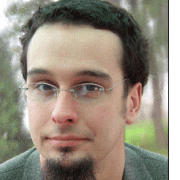Responding to the Second Shock of Existence
Paper by Academic Director of CIW Zachary Stein & President Marc Gafni Published at World Future Review.

 Abstract: Foreshadowing arguments from the forthcoming book, Towards a New Politics of Evolutionary Love, this paper suggests that humanity is in the throes of a species wide identity crisis, precipitated by a broadening awareness of our impending self-inflicted extinction. This growing awareness that humanity is responsible for its own fate and the fate of the planet is referred to as the second shock of existence. The second shock has spawned a great deal of discussion about the need for revolutions in technological, economic, and ecological infrastructures, yet this focus on exteriors addresses only half the picture. Comparable revolutions of our interiors must also take place—radical transformations in the very structure of our consciousness and species-wide self-understanding. This is a call for attending to the interior dimensions of the current global crises, recommending in the strongest possible terms that tremendous energy and resources be rechanneled into planning for the vast educational reconfigurations facing humanity in the coming decades.
Abstract: Foreshadowing arguments from the forthcoming book, Towards a New Politics of Evolutionary Love, this paper suggests that humanity is in the throes of a species wide identity crisis, precipitated by a broadening awareness of our impending self-inflicted extinction. This growing awareness that humanity is responsible for its own fate and the fate of the planet is referred to as the second shock of existence. The second shock has spawned a great deal of discussion about the need for revolutions in technological, economic, and ecological infrastructures, yet this focus on exteriors addresses only half the picture. Comparable revolutions of our interiors must also take place—radical transformations in the very structure of our consciousness and species-wide self-understanding. This is a call for attending to the interior dimensions of the current global crises, recommending in the strongest possible terms that tremendous energy and resources be rechanneled into planning for the vast educational reconfigurations facing humanity in the coming decades.
Keywords: Global crises; Integral Theory; Human Identity; Unique Self Theory; Cultural Evolution
Because of the current state of copyright law we only provide a pre-publication draft of this paper. There are bound to be errors that were corrected as the manuscript went through to press, so please track down the published version before citing any of this material or contact us for permission.
Stein, Z. & Gafni, M. (2015). Reimagining humanity’s identity: responding to the second Shock of existence. World Future Review. 7(1) 1-10. [pdf]
From the paper:
Today, in the maelstrom of post-modernity we are collectively facing the second shock of existence*, which is the realization that the survival of the entire human race is in danger.Moreover, we now face this second shock—this awareness of the mortality of the species—precisely because of the actions that followed in the wake of the first shock. Our attempts to build a world that would insulate us from death have brought us to a point where we must now face death on a scale that is almost unimaginable. The more perceptive among us know that it is our own actions that brought us to this point, and we know that it is only by our own actions that we might avoid the apocalyptic scenarios that haunt our collective imagination. Nothing defines our era more than the dawning awareness of the possibility of the self-inflicted extinction of the human race.
We suggest that, in fact, the second shock of existence is an important, necessary, and world-historical millstone in the evolution of consciousness and culture. The first shock made us aware that death threatens the meaning of each individual’s existence; the second shock teaches that self-inflicted extinction threatens the meaning of the whole species’ existence. Just as the first shock was necessary in furthering humanity’s mature and complex relation to the universe, so the second shock is necessary as a further impetus toward greater maturity and complexity. However, whereas the first shock served to separate us from nature and each other, the second shock will serve to reunite us with the natural world and weave the diverse strands of our now fragmented global culture into a common humanity. The second shock is awakening us to the patterns that connect all of humanity as part of a common destiny, a destiny intimately tied into the future of the biosphere. The second shock is a deepening of humanity’s awareness of its place in the universe; it results in the dawning awareness of our profound ethical obligations as the sole stewards of humanity and the planet.
Humanity is now in a situation where we recognize (for the first time, really) that our ability to exploit nature is profoundly limited—we have run up against very real physical boundaries to our continued existence. At the same time, in some sectors, there is a dawning realization that we are already in possession of an unlimited resource—the power of human creativity and innovation, a realm in which there is no scarcity. The tensions between these two realities—dangerous scarcity alongside inspiring plentitude—define our age. It is an age in which heaven competes with hell for a chance to be born. Culturally, this has given us two camps: the pessimists and the optimists, both focused on the state of our techno-economic-ecological exteriors. Techno-Optimists see a future in which our current techno-economic systems are salvaged, re-designed, and made increasingly scientific, efficient, and profitable; we will avert ecological disaster by creating a hyper-scientific, human controlled Heaven on Earth. Pessimists see these very attempts at continued scientific control and economic growth as the problem, sensing that the technologically wrought future they yield will give us more of what we’ve already had for nearly a century: a techno-economic system that decimates communities and ecosystems, and that will eventually degrade the Earth until the biosphere is simply unable to sustain life. Both pessimists and optimists focus on external systems, processes, resources, technologies, and economies. When they speak of crises they refer to broken or scarce things (broken ecosystems, unhealthy food, toxic air, failing schools, etc.). When they speak of innovation, they mean the creation of new and better things (healthy forests, organic food, new energy technologies, fresh air, good schools, etc). The future is in the balance for both camps, no doubt, and they both set their focus on the impacts of science, with a focus on sustainability and the physical continuity of life as we know it.
*The term Second Shock was coined by Mauk Pieper, see Pieper, M. Humanity’s Second Shock and Your Unique Self. (Independent Publishing, 2014).
